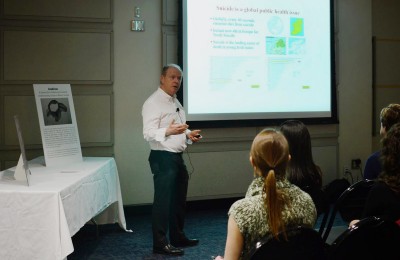
Stigma surrounding suicide in Ireland was highlighted through a collaboration of socially conscious art and research in “Stop the Silence,” a Thursday evening presentation in the Boston University Photonics Center.
Psychiatrist Kevin Malone and artist Seamus McGuinness presented their research collaboration under the project “Lived Lives” to demonstrate the rising suicide rate in Ireland among people under the age of 35. Approximately 80 Boston citizens and members of the BU community attended the presentation.
“Lived Lives” is a Ph.D. project in the School of Medicine and Medical Science at the University College Dublin that works to explore the human side of Ireland’s suicide statistics, according to the project’s website.
“The importance of ‘Lived Lives’ is it makes the unphysical physical,” McGuinness said following the presentation. “Most people that [have an] experience [with] suicide think it is a very private painful death, and people don’t like to talk about it because there is a stigma.”
Someone commits suicide in Ireland every 40 seconds, according to the presentation. McGuinness and Malone interviewed 62 families on their experiences of losing a family member to suicide from 2006 to 2010, according to the project’s website.
“It is a universal loss to people, and we just really have to do something about it,” McGuiness said. “To me, the most important thing about it is to make that painful experience physical to others who may not have experienced it.”
During the presentation, McGuinness showed a video of an exhibit comprised of items and clothing sent by family and friends of the deceased. McGuinness separated out and cut pieces of clothing into fragments that weighed 21 grams each — the weight of the soul, he said. The clothes were then suspended in the air by a string for people to observe and touch.
Hyeouk Hahm, a professor in the BU School of Social Work and organizer of the presentation, said the exhibit involving the suicide victims’ clothing was a good example of how to spur discussion.
“As soon as we are born, we are surrounded by the cloth and it’s like becoming our own conscious,” Hahm said after the event, “and I think he kind of touches who we are as human beings.”
Similar research projects and presentations should be open to rid suicide of negative stigma and encourage people who are at risk of committing suicide to seek help, Hahm said.
“I was so moved by his presentation,” she said. “I really feel like more people should know about this. We should really use social media to reach out to the young people, because young people have very high suicide rates.”
There were several other “Lived Lives” art pieces displayed in the presentation, including portraits of the victims and items important to the victims’ lives. The art shown served as a vehicle for attendees to view artifacts of suicide victims and participate in discussion about a taboo topic, Hahm added.
“I wanted to bring this work to Boston because it was too precious to be hidden in Ireland,” Hahm said.
Several attendees said the presentation provided them with an insight about an issue that is also prevalent in the United States.
Sally Johnson, 63, a Milton resident and 1978 BU graduate, said discussion is key in prevention and exploration into the issue of suicide.
“Not talking about tough things like suicide is so wrong and so isolating to the survivors, family and friends,” she said. “People have to be able to talk about this. It’s part of the healing, and so having something interactive in a creative way just combines things magnificently.”
Beleny Reese, a first-year graduate student in the School of Public Health, said seeing others experience the art firsthand was inspiring and added a human element to the academic discussion of suicide research.
“Watching the video and seeing that people would approach these textiles and feel them but manipulate them in such a way that they were searching,” she said, “you know they were searching for a missing piece. They were searching for an answer, and that is what makes the problem so hard.”
Julianne Wilner, a doctoral student in the Graduate School of Arts and Sciences who works at the Center for Anxiety and Related Disorders, said the artistic involvement in the project was an important way to shed a light on methods of prevention.
“We do so much psycho-social intervention research, but … an artistic intervention brought such a different conceptualization of what prevention efforts can look like,” she said. “We do one-on-one group therapy for individuals who might be at risk for suicide, but nothing that looks like this.”
























































































































Hyeouk Chris Hahm • Mar 18, 2016 at 7:31 pm
Steven,
Thanks so much for writing this article. Can you make one correction here! The article said,
“Someone commits suicide in Ireland every 40 seconds, according to the presentation” but in fact, globally, a suicide death occurs on average every 40 seconds. Please make a correction immediately, so that public will be informed with a correct information. Thanks again. Hyeouk Chris Hahm